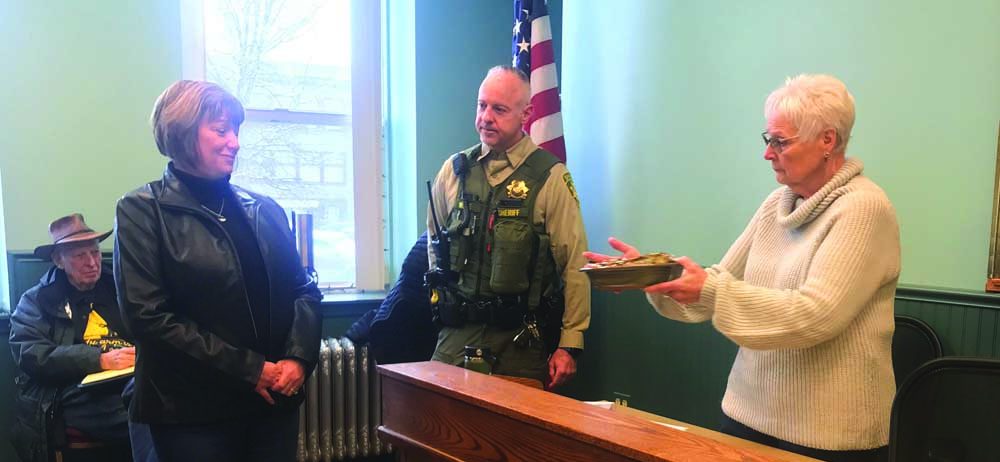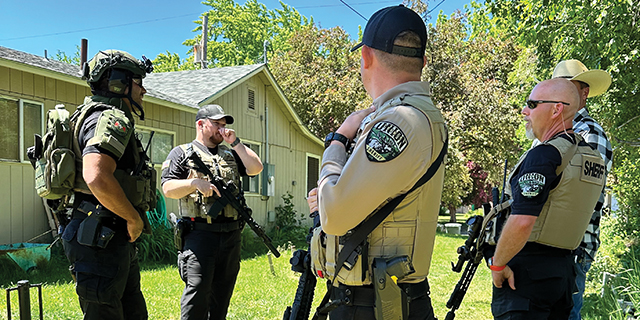Summit Fever
Published 10:55 am Tuesday, June 22, 2021

- Jayson Jacoby
I wedged my right hand into a crevice in the sedimentary stone and hauled myself up the final few feet to the summit of the great peak.
And there I dropped to my knees.
But not in triumph or elation.
This was vertigo.
Several years had passed since I last stood atop Elkhorn Peak, and it seems I had forgotten how exposed this aerie is.
My knees had forgotten, anyway. They refused to be still and support my weight as they’re supposed to.
My wife, Lisa, and our son, Max, clambered up the last pitch behind me.
Max, who’s 10 and was making his first visit to this second-highest point in the Elkhorn Mountains west of Baker City, reacted much as I did when he saw the void off the east side of the peak.
He hunkered down beside the conical rock cairn that adds a few feet to the mountain’s official elevation of 8,931 feet.
I fall, so to speak, around the middle on the acrophobia scale, and I regained my equilibrium in a couple minutes.
And then promptly went all woozy again when I launched our drone.
Many people, of course, can feel a trifle dizzy when they are standing on an exposed perch and then look up.
I’m prone to the condition myself.
But adding a small flying object to the scene accentuated the effect to an extent that surprised me. It was as if my subconscious insisted that I wasn’t standing on solid rock but was instead up there with the drone.
It was disconcerting. I had to return to a kneeling position for the rest of the brief flight, which at least yielded a compelling piece of video and several photographs from vantage points otherwise inaccessible.
Although Elkhorn Peak falls 175 short of Rock Creek Butte, its neighbor across Twin Lakes basin, as the apex of the Elkhorns, the former summit has an unsurpassed view.
From most places in Baker City, Elkhorn Peak is the highest point visible in the range. Its bulk hides Rock Creek Butte, which is a bit west of Elkhorn Ridge, the spine of high ground that dominates the western horizon from town.
Among the significant summits in the area, Elkhorn Peak is comparatively easy to reach.
Depending on how you go, the drive to the trailhead might be the most punishing, and possibly the slowest, part of the trip.
The least taxing option, and the one we chose on June 19, is by way of Marble Creek Pass and the Elkhorn Crest National Recreation Trail.
There are two routes to the pass, one from the Baker Valley side, the other from Sumpter Valley. The road is steep and rocky on both sides, but the Sumpter Valley route is marginally less awful.
The Elkhorn Crest Trail, by contrast, is a pleasure.
Few if any trails in Oregon reward hikers with such grand vistas for so little physical effort. The trail, as its name suggests, follows the crest of the Elkhorns. And although it’s not quite flat, the grade is so gentle as to be all but imperceptible.
Marble Creek Pass is the southern terminus of the trail, which runs north for 23 miles to Anthony Lakes.
The trail stays on the west side of Elkhorn Ridge for the first three miles, so the most expansive view is in that direction. A blue finger of drought-depleted Phillips Reservoir is visible due south, and all major peaks and ranges in the southern Blue Mountains are arrayed, including Table Rock and Monument Peak, Strawberry Mountain, Dixie Butte, Vinegar Hill and the rest of the Greenhorn Range, Desolation Butte and, nearer than any others, Mount Ireland.
But the trail also veers into a couple of notches in the crest, and from there the view of Baker City and Baker Valley is reminiscent of what you might see from an airplane.
The Wallowas dominate the northeast skyline, and due east the view extends well into Idaho.
The Elkhorn Crest Trail runs through a quintessential alpine landscape, the slopes brightened by a palette-spanning selection of wildflowers, including purple lupine and penstemon, orange Indian paintbrush, white phlox and blue flax.
Just two conifers grow in this harsh country, where snow lies for more than half the year and the wind is nearly constant — subalpine fir and whitebark pine.
The latter species is my favorite.
Whitebarks rarely exceed 40 feet in height — those incessant gusts discourage tall vegetation — but they can live for many centuries, and over those vast spans their trunks can grow thicker than an elephant’s leg.
Whitebarks are if anything more attractive in death than in life — their limbs contorted into fanciful shapes, the wood weathered to a sheen that can look as though it had been sanded and polished by a skilled hand.
The highlights of a hike along the Elkhorn Crest often aren’t limited to the floral.
The area between Marble Creek Pass and Elkhorn Peak is prime habitat for the mountain goats that have thrived in the range since the Oregon Department of Fish and Wildlife released the first batch in 1983 along Pine Creek, just north of Elkhorn Peak.
I saw five goats on our hike — including a nanny and three kids reclining on a snowfield, the animals’ favorite spot on summer afternoons.
But if you’re patient, and bring binoculars, you’re almost certain to see far more goats than I did. The best places to look are those aforementioned notches along the trail, as goats prefer the nearly sheer east side of the ridge, where their surefootedness makes them all but immune to predators.
There is no trail to the top of Elkhorn Peak.
The easiest way to get there is to hike the Crest Trail for about 2.75 miles north from Marble Creek Pass, then pick your way up the slope to the peak’s south ridge.
We diverted from the trail about where it bends to the west. The climb to the ridge is steep but not technical. We had to bypass a steep snowfield, but I expect it will be melted by mid July.
The ridge drops steeply — dangerously so — on its east side, so unless you’re equipped for roped climbing, stay well to the west (left) of the ridgetop (besides which, the area east of the ridge is part of Baker City’s watershed, which is off limits to the public). There is a false summit a couple hundred feet below the peak — this notch is distinct even when seen from Baker City, just to the left of the triangular tip of the summit.
From the top you can see four lakes.
Almost directly below to the east — and about 2,300 vertical feet — is Goodrich Lake. The lake is a supplementary water source for Baker City.
Pine Creek Reservoir is barely visible to the northeast, and Twin Lakes glisten in the sunshine to the northwest.
Twin Lakes are tarns — they formed in the basin gouged by an Ice Age glacier.
The hulking peak that forms the backdrop for Twin Lakes is Rock Creek Butte, elevation 9,106 feet.
Although the fastest way back to the trailhead is to reverse your route, it’s also possible to descend Elkhorn Peak by its northwest ridge — again, stay to the west to avoid the steepest ground — to Twin Lakes saddle.
Here a trail branches off the Elkhorn Crest Trail and descends to Twin Lakes. From the saddle it’s about 3.5 miles to Marble Creek Pass.
Hikers with an abundance of energy (and enough water; one downside of the Elkhorn Crest Trail is that it doesn’t cross any water sources) can claim the top two summits in the Elkhorns in a single day. To climb Rock Creek Butte, hike north on the Crest Trail for about a mile, through a scenic pass.
Just beyond the pass, head straight up the south ridge of Rock Creek Butte. It’s about 800 vertical feet from the trail to the summit.





